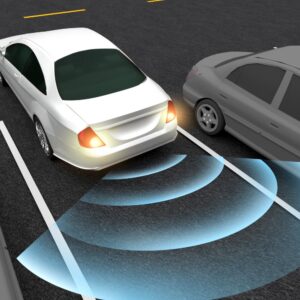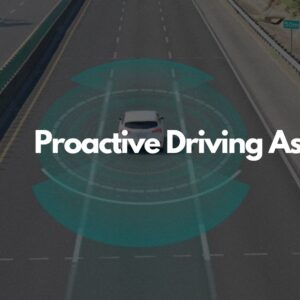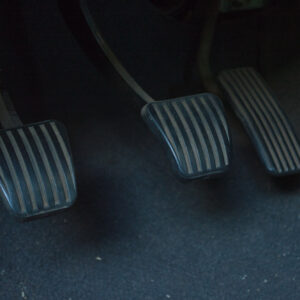Technological innovations in the automotive industry have become so advanced that most of our work has been cut out for us when it comes to driving.
Driver assistance features have become so smart that most modern vehicles are now capable of detecting pedestrians, oncoming vehicles, and other obstacles that could get in the way and potentially cause an accident.
One such feature is the traffic jam assist system, which a lot of automakers are now integrating into their new releases.
How Does Traffic Jam Assist Work?
Traffic jam assist is an innovative safety feature that works a lot like adaptive cruise control that’s integrated with lane centering. This feature is a Level Two driver assistance system that operates at speeds of 40 mph or less.
Using a front-mounted radar sensor and several cameras, the system monitors road traffic and lane markings to detect nearby vehicles and other relevant traffic information.
Vehicles with a traffic jam assist feature will automatically stop or slow down once the system detects a delay in the driver’s response. Traffic jam assist is also capable of adjusting vehicle speed and steering the car.
This feature eliminates the need for the driver to work the accelerator pedal and brakes whenever they’re driving through heavily congested roads.
However, it’s still important for drivers to remain alert even if their vehicles have this feature.
Once traffic jam assist brings the vehicle to a complete stop, the same feature is also capable of resuming driving once the traffic moves.
In most cases, however, the driver will need to step on the gas pedal lightly to re-engage the system if it hasn’t moved in over 30 seconds. The traffic jam assist also disengages if the driver leaves the steering wheel alone for too long.
Given that the traffic jam assist is a Level Two Advanced Driver Assistance Systems (ADAS) feature, it falls under the partial automation category.
Level Two ADAS features let vehicles operate autonomously with complex functions such as steering, braking, and accelerating.
Together with traffic jam assist, other driver assistance features that fall under this category are limited to providing the following:
- Warnings and momentary assistance (e.g. blind spot warning, automatic emergency braking)
- Steering support
- Brake acceleration support
Traffic jam assist systems also use lane-centering technology to prevent the vehicle from drifting.
By using cameras to identify lane markings, the system can provide steering inputs and implement minor corrections to keep the vehicle in its lane. Switching lanes will cause the system to override and map out the new lane markings.
How to Use Traffic Jam Assist
In most cases, the traffic jam assist feature activates under certain conditions.
In some Honda vehicles, for example, the feature kicks in when the following scenarios are present:
- Lane-keeping assist feature is activated
- There are detectable lane markers
- Vehicle speed is anywhere between 0 and 45 mph
- The driver is gripping the steering wheel
- The shifter is in D, S, or L.
The exact manner of operation of this feature can vary, depending on the vehicle’s specifications. While this might be the case, the traffic jam assist function from various models generally shares the same principles.
Before using this feature, it’s important to check your owner’s manual to get an overview of the entire system and how the traffic jam assist function engages/disengages. Reviewing the manual will also give you information on the system’s limitations.
Even if the traffic jam assist feature is in full effect, drivers must still pay attention to highway ramps, exits, and intersections.
It’s also crucial to follow permitted speed limits based on the road and weather conditions.
What Are the Limitations of Traffic Jam Assist?
Although the traffic jam assist feature is extremely helpful and convenient, drivers shouldn’t neglect their responsibility of paying attention to the road.
Traffic jam assist is not autonomous driving. This means that the feature is incapable of completely taking over for the driver when it comes to navigating roads.
Instead, traffic jam assist is a semi-autonomous feature that still requires driver supervision. Drivers should treat the system as a guide to help them maintain a safe distance from other vehicles and keep them in their lanes.
Also, it’s best to keep in mind that the feature only operates at low speeds.
Traffic jam assist works best when driving on highways. It isn’t exactly helpful in areas where stoplights and other road signs are common.
Additionally, the feature has limited capabilities when it comes to the following conditions:
- Sharp roads or those with winding curves
- Highway interchanges (e.g. entry and exit points)
- Debris-filled roads
- Roads with unclear markings
- Poor weather conditions (e.g. heavy rain, snow, or fog)
- Motorcycle and bike-filled streets
- Underinflated tires or tires with insufficient tire tread
Traffic Jam Assist In Practice
Traffic jam assist is slowly becoming a staple feature in many vehicles, and it usually comes as part of a package.
For instance, the Toyota traffic jam assist feature is included in the model’s Safety Sense system, which includes other features like lane departure alert, pre-collision system, and road sign assist, among others.
Meanwhile, Audi’s traffic jam assist feature is included in the Audi Pre Sense System, which is a package that comes with driver assistance, adaptive cruise control, and parking assistance technology.
Below are other automakers that offer vehicles with traffic jam assist:
- Mazda (Intelligent Transport System)
- Honda (Honda Sensing System)
- BMW (BMW ConnectedDrive Suite)
- Volkswagen (all models with an automatic transmission)
- Acura (AcuraWatch System)
- Mercedes-Benz (Drive Pilot System)
Any information provided on this Website is for informational purposes only and is not intended to replace consultation with a professional mechanic. The accuracy and timeliness of the information may change from the time of publication.






















